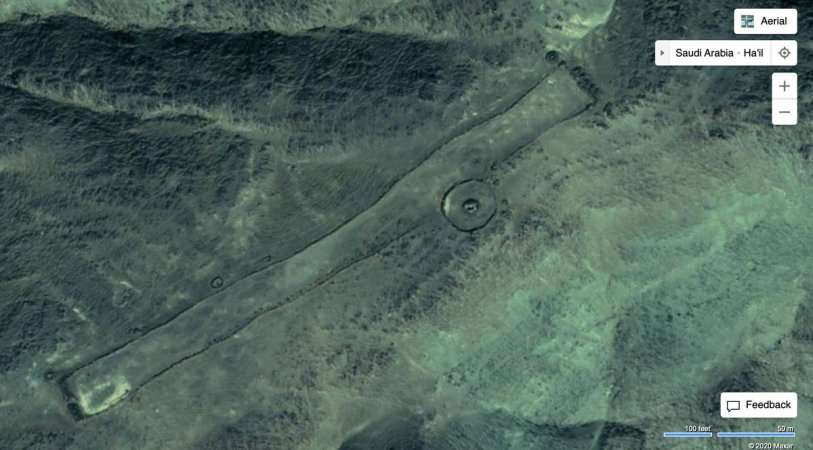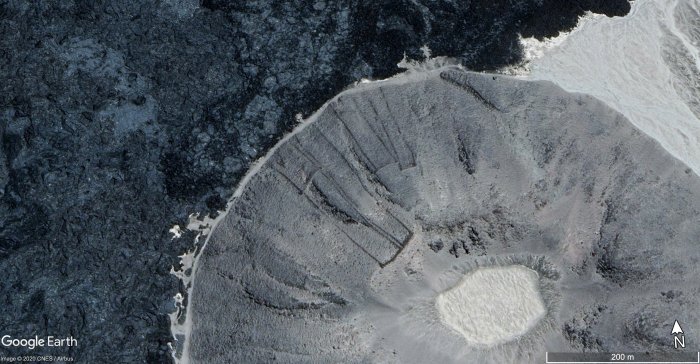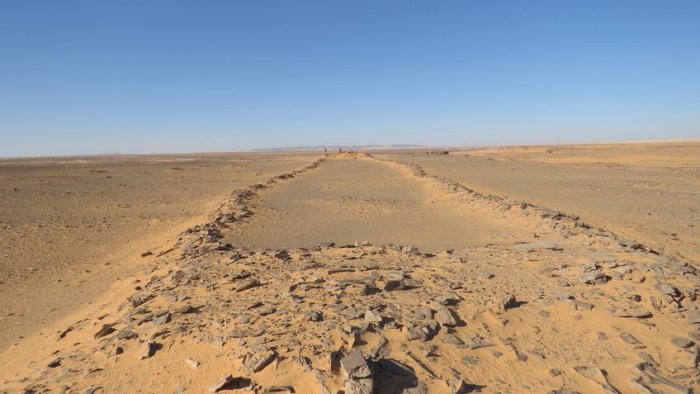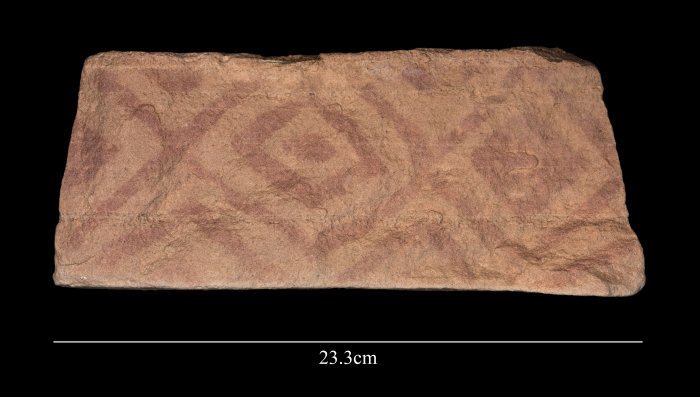
Satellite image of a mustali in Saudi Arabia.
Posted on 08/24/2020 11:06:33 PM PDT by BenLurkin
The mustatils are giant stone monuments that are about 7,000-year- old. The Arabic name ‘mustatils,’ means rectangle.
These vast structures made of stone piled into rectangles, are some of the oldest large-scale structures in the world.
Mustalis were previously recognized from satellite imagery and as they were often covered by younger structures, it had been speculated that they might be ancient, perhaps extending back to the Neolithic.
Recent studies reveal new, interesting information that may shed light on the purpose of these massive stone monuments.
Dr. Huw Groucutt from the Max Planck Institutes for Chemical Ecology, the Science of Human History, and Biogeochemistry conducted together with an international team a thorough study of these enigmatic stone structures.
At one mustalis, Dr. Huw Groucutt and his team found animal bones, which included both wild animals and possibly domestic cattle, although it is possible that the latter are wild auroch. At another mustatil the team found a rock with a geometric pattern painted onto it.
Northern Arabia 7,000 years ago was very different to today. Rainfall was higher, so much of the area was covered by grassland and there were scattered lakes. Pastoralist groups thrived in this environment, yet it would have been a challenging place to live, with droughts a constant risk.
They may not be the oldest buildings in the world, but they are on a uniquely large scale for this early period, more than two thousand years before pyramids began to be constructed in Egypt.
Arabia, many ancient structures have received little attention, and therefore, megalithic structures of the region remain largely unknown. Recently, scientists discovered a 35-meter-long stone platform dated to 6,000 B.C. Such intriguing archaeological discoveries give us reason to say the Arabian Desert still holds many ancient secrets waiting to be revealed
(Excerpt) Read more at ancientpages.com ...
ping
Rocky outside the things, not rocky inside the things.
My first guess was farm plots. That long ago, might have been enough water/rain in the area to make it work.
But then I noticed the interior was elevated over the exterior in the pic I was looking at so the “not rocky inside” might be from wind drifted silt built up over the long while?
Equivocation is like driving down the middle of the road, pretty soon there’s going to be a badd accident

Satellite image of a mustali in Saudi Arabia.

Several mustalis visible on Google Earth.

Mysterious Mustatils- Giant 7,000-Year-Old Stone Monuments In Saudi Arabia Baffle Scientists AncientPages.com | August 19, 2020 | Ancient Places, Archaeology, News Share via FacebookShare via TwitterShare via PinterestShare via RedditShare via Email Jan Bartek - AncientPages.com - Thousands of years before the Egyptian pyramids, Stonehenge, and the Maltese temples were built, people of Arabia constructed the mustatils. The mustatils are giant stone monuments that are about 7,000-year- old. The Arabic name ‘mustatils,’ means rectangle. Mysterious Mustalis - Giant 7,000-Year-Old Stone Monuments In Saudi Arabia Baffle Scientists Satellite image of a mustali in Saudi Arabia. Credit: Dr Huw Groucutt The purpose of these mysterious structures is unknown, but there are some theories attempting to explain what promoted the sudden construction of these enigmatic stone structures. Hundreds Of Mustalis Were Constructed In The Arabian Desert Archaeologists have hundreds of mustalis in the Arabian Desert. These vast structures made of stone piled into rectangles, are some of the oldest large-scale structures in the world. What is interesting about these giant monuments is that they only occur in northwest Saudi Arabia. Mustalis were previously recognized from satellite imagery and as they were often covered by younger structures, it had been speculated that they might be ancient, perhaps extending back to the Neolithic. Recent studies reveal new, interesting information that may shed light on the purpose of these massive stone monuments. Dr. Huw Groucutt from the Max Planck Institutes for Chemical Ecology, the Science of Human History, and Biogeochemistry conducted together with an international team a thorough study of these enigmatic stone structures. Mysterious Mustalis - Giant 7,000-Year-Old Stone Monuments In Saudi Arabia Baffle Scientists Several mustalis visible on Google Earth. Credit: Dr. Huw Groucutt So far the science team has identified more than one hundred new mustatils have been identified around the southern margins of the Nefud Desert, between the cities of Ha’il and Tayma, joining the hundreds previously identified from studies of Google Earth imagery, particularly in the Khaybar area. The researchers found that these structures typically consist of two large platforms, connected by parallel long walls, sometimes extending over 600 meters in length. The long walls are very low, had no obvious openings and are located in diverse landscape settings. It is also interesting that little in the way of other archaeology – such as stone tools – was found around the mustatils. What Was The Purpose Of The Giant Mustalis? No one can say with certainty why people built the mustalis thousands of years ago, but considering the monuments have been found in such large numbers, the structures must have been important to people in the Arabian Desert. Were the mustalis animal shelter, ritual sites or did they serve a completely unknown purpose we simply cannot figure out? At one mustalis, Dr. Huw Groucutt and his team found animal bones, which included both wild animals and possibly domestic cattle, although it is possible that the latter are wild auroch. At another mustatil the team found a rock with a geometric pattern painted onto it. Based on the archaeological discoveries so far, scientists suggest mustlais were ritual sites, where groups of people met to perform some kind of currently unknown social activities. The fact that sometimes several of the structures were built right next to each other may suggest that the very act of their construction was a kind of social bonding exercise. Northern Arabia 7,000 years ago was very different to today. Rainfall was higher, so much of the area was covered by grassland and there were scattered lakes. Pastoralist groups thrived in this environment, yet it would have been a challenging place to live, with droughts a constant risk. Mysterious Mustalis - Giant 7,000-Year-Old Stone Monuments In Saudi Arabia Baffle Scientists View along the length of a mustatil structure, note researchers at far end for scale, image shows character of these structures as two platforms connected by low walls.

View along the length of a mustatil structure, note researchers at far end for scale, image shows character of these structures as two platforms connected by low walls.

"An interesting feature of these structures is that despite very high visibility (i.e. often directly on bedrock), we observed few artefacts around them, but we did find this beautiful painted rock in the platform of one mustatil," Dr. Huw Groucutt said.
:max_bytes(150000):strip_icc()/Aliens-5ad4ee9231283400363d13c4.jpg)
This is blatant political ads

I have trouble believing this claim, since I am 68 years old, and am just hearing about this sp-called antiquity, as of this news article!!
"An interesting feature of these structures is that despite very high visibility" (i.e. often directly on bedrock)
OK, If hundreds of them were built, my gut tells me it had to be something that warranted the effort to build. Something related to survival. Was it a method of capturing precious water? Or confining herds of livestock as mentioned.
Looks like a fish farm to me.
Did you hear about the tree trunk? The Devil’s Tower seems to have actually been a tree!!
https://twitter.com/ValiantThor12/status/1297677626992144389
maybe sheep pens
Could be, but this is the desert.
Could be, but this is the desert.
Imagine a long channel of rocks allowing the air to circulate to bedrock. You could collect moisture and it run down the bedrock to a collection point. Have you ever observed how much water condenses from an air conditioner? I’ve seen the same effect in Heliax cable, if it is not filled with nitrogen. 1,000 ft. of cable will precip more moisture than you think possible. there is a big temp gradient on a vertical 1,000 ft collector.
I’ve seen solar moisture collectors designed for remote use in Mexico. Simple, relatively slow, but they can draw water right out of the air.
I think Sumer is still the cradle of civilization
Disclaimer: Opinions posted on Free Republic are those of the individual posters and do not necessarily represent the opinion of Free Republic or its management. All materials posted herein are protected by copyright law and the exemption for fair use of copyrighted works.